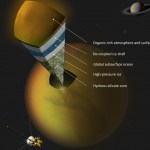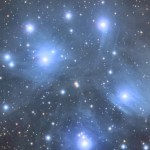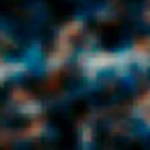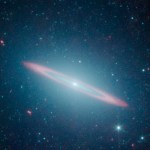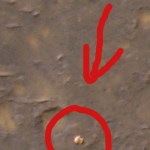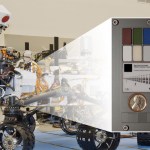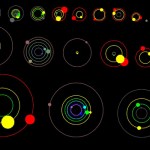Cosmos
We're getting closer to the Impossible Landing that NASA is going to attempt on Mars, and the space agency has sent out a new press release.
The area where NASA's Curiosity rover will land on Aug. 5 PDT (Aug. 6 EDT) has a geological diversity that scientists are eager to investigate, as seen in this false-color map based on data from NASA's Mars Odyssey orbiter. Image credit: NASA/JPL-Caltech/ASU
NASA's most advanced planetary rover is on a precise course for an early August landing beside a Martian mountain to begin two years of unprecedented scientific detective work. However, getting…
The whole Higgs Boson thing is really interesting. Not only was is not discovered over the last several months, but in a way that makes it certain that it exists, but for other reasons as well. Higgs himself predicted its existence a very long time ago and was told by the greats that it really can't exist, so he should be a model for all those people with Theories ... like "they didn't believe Higgs either, so I must be right!" ... but instead the usual suspects have lined up (at least in the spam section of my blogs) to tell us how the Higgs Particle itself is a conspiracy.
Another thing is…
From CERN:
CERN experiments observe particle consistent with long-sought Higgs boson
Geneva, 4 July 2012. At a seminar held at CERN1 today as a curtain raiser to the year’s major particle physics conference, ICHEP2012 in Melbourne, the ATLAS and CMS experiments presented their latest preliminary results in the search for the long sought Higgs particle. Both experiments observe a new particle in the mass region around 125-126 GeV.
“We observe in our data clear signs of a new particle, at the level of 5 sigma, in the mass region around 126 GeV. The outstanding performance of the LHC and ATLAS…
I thought many of you would want to know about this book. It is from the National Academies Press. Costs 40 bucks if you want the dead tree version, but the PDF is free. Gotta love the National Academies.
Here's the description provided by the NAP:
In the five decades since NASA was created, the agency has sustained its legacy from the National Advisory Committee on Aeronautics (NACA) in playing a major role in U.S. aeronautics research and has contributed substantially to United States preeminence in civil and military aviation. This preeminence has contributed significantly to the…
Apparently not, but something interesting is happening.
The buzz on the blogosphere is that there will be an announcement on July 4th that the Higgs Boson has been proven to exist, but not "found." And by "proven" it is meant that empirical evidence of its existence has been gathered, as opposed to a mathematical argument that it must exist or that they have a jar of them and are ready to pass out free samples to reporters. One of the project researchers, John Ellis, has said "We've discovered something which is consistent with being a Higgs."
What is the Higgs Boson? George Musser will…
Just so you know, scientists do not seem to be able to detect the difference between a 3 foot and a 30 foot deformation of the surface of a planetoid body that is about one and a half billion kilometers away, and we know this because NASA's Cassini space ship had to actually go all the way to one of Saturn's moons, Titan, to discover that the tidal deformation of the surface is more like 30 than 3 feet in magnitude. This, in turn, strongly suggests that Titan has an ocean of some kind under its surface. Thus, the Sirens. The Sirens of Titan.
NASA provides us with the following artists…
This is like an episode of Dr. Who. A star erupted and vaporized the atmosphere of a nearby planet. Holy crap. Details:
JUNE 28, 2012: An international team of astronomers using data from the NASA's Hubble Space Telescope has made an unparalleled observation, detecting significant changes in the atmosphere of a planet located beyond the solar system. The scientists conclude that the atmospheric variations occurred in response to a powerful eruption on the planet's host star, an event observed by NASA's Swift satellite. This artist's rendering illustrates the evaporation of exoplanet HD…
Astronomers have discovered something that should not be there. It is an arc of light. The arc is the effect of gravitational lensing which happened as light passed by a massive galaxy about 10 billion years ago in space-time. In other words, in this universe, but very far away and a very long time ago, when our universe was a mere toddler. The galaxy that supplies the light is even farther away.
(UPDATE: See this post by Phil Plait for a detailed writup on this observation: The galaxy that shouldn’t be there)
Here's the problem. A very massive galaxy...the one that is farthest away...…
Today is the anniversary of the discovery, by John Tebbutt of New South Wales, Australia, of the Great Comet of 1861. Tebbutt was an astronome.
The comet was initially visible only in the southern hemisphere, but then became visible in the northern hemisphere on about June 29th. I find it interesting that word of the commet spread slowly enough that it was sen in the north before it was heard of.
It has been suggested that this comet had been previously sighted in April of 1500 (that comet is now known as C/1500 H1). The comet will return during the 23rd century.
source
The Sombrero Galaxy's Split Personality: The infrared vision of NASA's Spitzer Space Telescope has revealed that the Sombrero galaxy -- named after its appearance in visible light to a wide-brimmed hat -- is in fact two galaxies in one. It is a large elliptical galaxy (blue-green) with a thin disk galaxy (partly seen in red) embedded within. Previous visible-light images led astronomers to believe the Sombrero was simply a regular flat disk galaxy. Spitzer's infrared view highlights the stars and dust. The starlight detected at 3.5 and 4.6 microns is represented in blue-green while the…
Who says that if you scream in space no one will hear you?
A rare daytime meteor was seen and heard streaking over northern Nevada and parts of California on Sunday, just after the peak of an annual meteor shower.
Observers in the Reno-Sparks area of Nevada reported seeing a fireball at about 8 a.m. local time, accompanied or followed by a thunderous clap that experts said could have been a sonic boom from the meteor or the sound of it breaking up high over the Earth.
source
Here's an animation:
And now, a bonus question: Why do they call Sparks "Sparks"?
NASA's Dawn spacecraft has revealed unexpected details on the surface of the giant asteroid Vesta. New images and data highlight the diversity of Vesta's surface and reveal unusual geologic features, some of which were never previously seen on asteroids.
These results were discussed today at the Lunar and Planetary Science Conference at The Woodlands, Texas.
... Dawn has found that some areas on Vesta can be nearly twice as bright as others, revealing clues about the asteroid's history.
"Our analysis finds this bright material originates from Vesta and has undergone little change since the…
Neil deGrasse Tyson has a new book out: Space Chronicles: Facing the Ultimate Frontier. It is (as one might guess) about space exploration, and assembles earlier speeches and writings with some new stuff. This is an interesting time to be talking about the space program, as NASA seems to be producing new results ever week, there are large and small space robots on their way to distant orbs, or soon to be launched, we are on the verge of understanding the potential of life on Mars on a basic level, we are finding more earth-ish Exoplanets and at the same time the sky is falling, or at least…
... Well, everything is in space, but I mean outer space!
Observations by NASA's Hubble Space Telescope have come up with a new class of planet, a waterworld enshrouded by a thick, steamy atmosphere. It's smaller than Uranus but larger than Earth.
Zachory Berta of the Harvard-Smithsonian Center for Astrophysics (CfA) and colleagues made the observations of the planet GJ1214b.
"GJ1214b is like no planet we know of," Berta said. "A huge fraction of its mass is made up of water."
The ground-based MEarth Project, led by CfA's David Charbonneau, discovered GJ1214b in 2009. This super-Earth is…
From Science Insider, there is a possible explanation for the recently observed "faster than light" neutrinos. The Neutrinos were clocked at faster-than-light speeds on their way form CRN in Switzerland to a detectors site in Italy. I had originally proposed that the neutrinos were merely very hungry but unwilling to eat Swiss food, and since they were on their way to Italy, why not go FTL?
The research at first was assumed to most likely be some kind of mistake, but a Mulligan Redo Procedure clearly demonstrated that the most obvious errors could not explain the observation, which violates…
PASADENA, Calif. -- Astronomers using data from NASA's Spitzer Space Telescope have, for the first time, discovered buckyballs in a solid form in space. Prior to this discovery, the microscopic carbon spheres had been found only in gas form in the cosmos.
Formally named buckministerfullerene, buckyballs are named after their resemblance to the late architect Buckminster Fuller's geodesic domes. They are made up of 60 carbon molecules arranged into a hollow sphere, like a soccer ball. Their unusual structure makes them ideal candidates for electrical and chemical applications on Earth,…
... well, not really, but ...
No matter how interesting the big expensive science NASA does is, or how important the work is to understanding our planet and solar system or figuring out important problems, nothing is as cool as seeing your own house on a satellite photograph, as it were:
The High Resolution Imaging Science Experiment (HiRISE) camera on NASA's Mars Reconnaissance Orbiter recorded a scene on Jan. 29, 2012, that includes the first color image from orbit showing the three-petal lander of NASA's Mars Exploration Rover Spirit mission. Spirit drove off that lander platform in…
This August, Mars Science Robot Curiosity will land on the surface of the Angry Red Planet equipped with a Penny to tell how big things are.
The camera at the end of the robotic arm on NASA's Mars rover Curiosity has its own calibration target, a smartphone-size plaque that looks like an eye chart supplemented with color chips and an attached penny.
When Curiosity lands on Mars in August, researchers will use this calibration target to test performance of the rover's Mars Hand Lens Imager, or MAHLI. MAHLI's close-up inspections of Martian rocks and soil will show details so tiny, the…
Kepler has discovered 11 new "solar systems" with 26 confirmed planets among them. They:
Range from 1.5 Earths in radius to bigger than Jupiter
15 are between Earth and Neptune in size
They have years ranging from 6 to 143 days.
Their rockiness or gaseousness remains unassessed to date.
This artist's concept shows an overhead view of the orbital position of the planets in systems with multiple transiting planets discovered by NASA's Kepler mission. All the colored planets have been verified. More vivid colors indicate planets that have been confirmed by their gravitational interactions…
It is called NuStar, for "Nuclear Spectroscopic Telescope Array," and NASA will be launching this giant thing that looks like a dumpster on March 14th.
NASA's Nuclear Spectroscopic Telescope Array, or NuSTAR, mission is seen here being lowered into its shipping container at Orbital Sciences Corporation in Dulles, Va. The spacecraft is headed to Vandenberg Air Force Base in Central California, where it will be mated to its rocket. It is scheduled to launch from Kwajalein Atoll in the Marshall Islands on March 14. Image credit: NASA/JPL-Caltech/Orbital
When you look at the sky with your…


